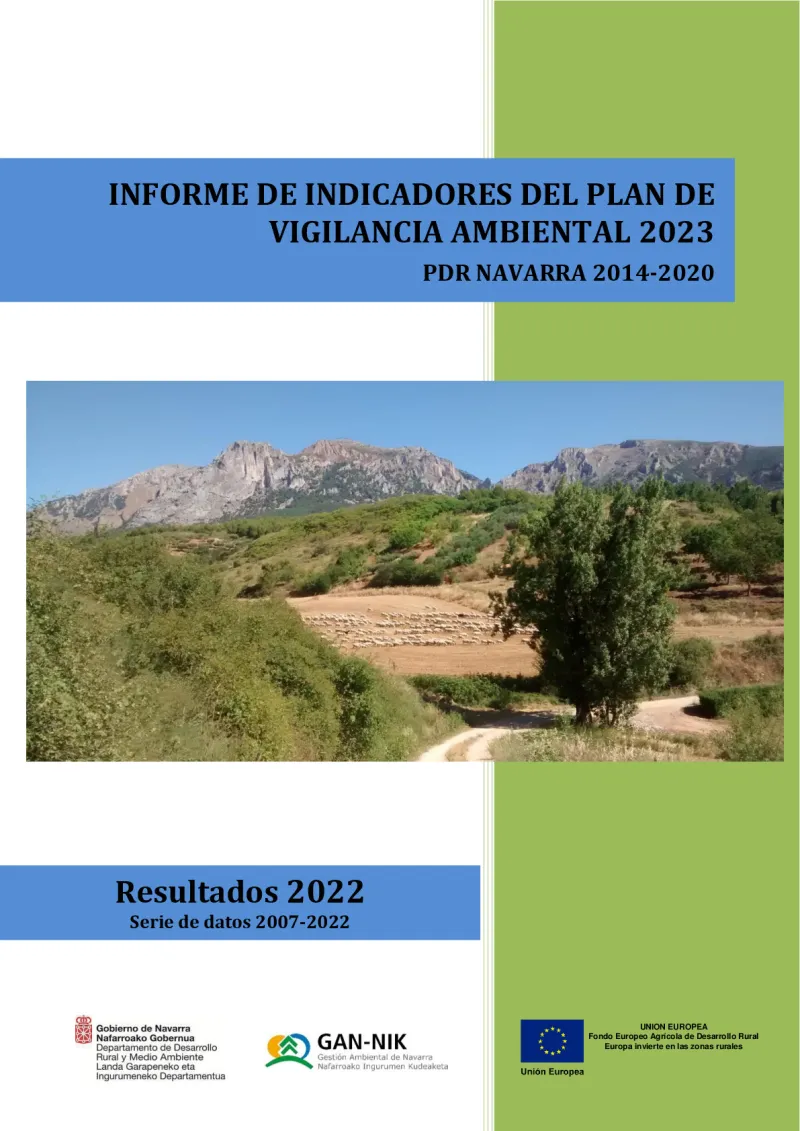Navarre RDP report on 2023 environmental monitoring plan indicators
The environmental impact statement of Navarre's 2014 Rural Development Programme includes an environmental monitoring plan, which evaluates proposed objectives through 35 agri-environmental indicators outlined in this report.
- Spain
- 2014-2022
- Environmental impacts

The environmental impact statement (strategic environmental declaration) of the 2014-2020 Rural Development Programme (RDP) of the autonomous community of Navarre (Resolution 74E/2015, of 5 February 2015) includes an environmental monitoring plan aimed at implementing environmental monitoring. This report reflects data from 2022 and previous years, based on the monitoring of the 2014-2020 RDP, including data from the monitoring of the previous 2007-2013 RDP, to have sufficiently representative data sets for each indicator to assess the trend of these data.
For each indicator, the report contains a fiche with the details of the indicator, including related objectives and measures, unit of measurement, calculation methodology, periodicity, reference targets and data sources. The evaluation concludes that, of the 35 indicators calculated in this report, 17 (49%) show a trend for the period corresponding to the 2014-2020 RDP in line with the established objective, while 16 indicators (46%) show a trend clearly contrary to the objective pursued. These data are somewhat better than those presented in the latest environmental monitoring plan.
Indicators related to the use of pesticides show trends opposite to the objective being achieved, although the intensity of phytosanitary application is significantly lower than the Spanish average. The area treated with pesticides has increased slightly in 2021, maintaining its clear upward trend, while the toxicity of the pesticides used is increasing.
Regarding fertiliser consumption per utilised agricultural area, it shows an upward trend and exceeds the average consumption in Spain. In terms of phosphorus and nitrogen concentration in agricultural soils, there is a downward trend in the first case and an increase in the second case.
The water quality and leachate reduction indicators indicate a positive trend for surface waters with respect to the objectives, except for pesticide concentration. In groundwater, however, all trends are upwards, both for nitrate content and for nitrite, ammonium and phosphate concentrations. Irrigation water consumption increased in 2022; however, in the long term, the indicator shows a very slight downward trend, which is in line with the set target.
Regarding erosion, it is highly influenced by rainfall, which exhibits significant year-on-year variations, as indicated by recent data. However, the trend has shifted from being stable to one of clear increase.
The energy efficiency indicators, which reflect energy consumption, continue their upward trend in the 2014-2020 RDP period and are therefore at odds with the set target. In contrast, the production of renewable energy by the primary sector is increasing, in line with the objective to be achieved.
Regarding greenhouse gas emissions in Navarre, a downward trend is shown, despite a slight increase in 2021. However, in the holdings benefiting from the RDP, emissions are rising. In terms of ammonia emissions, they are increasing both in Navarra and in farms receiving support from the RDP.
The increase in forest areas to increase the carbon sink effect has an increasing trend, in line with the stated objective. In relation to the protection of biodiversity, the trends shown by the indicators are uneven. The proportion of the area of holdings receiving RDP aid within the Natura 2000 network is decreasing, despite the increase in the number of hectares for 2022, similarly to the diversity of land use.
The development and promotion of organic production continue to maintain a general upward trend, aligning with the set objective. On farms receiving RDP funds, the trend in both agriculture and livestock farming is clearly upwards. Regarding the evolution of the forage area (indicator 31), the trend continues upward (according to the objective), with a slight increase in 2022 in the area, both in total and subsidised by the RDP.
Author(s)
Silvia Zabalza and Carlos Astrain, GAN-NIK (Gestión Ambiental de Navarra)